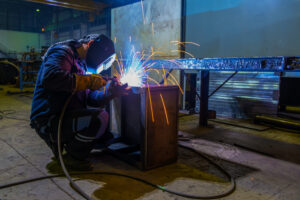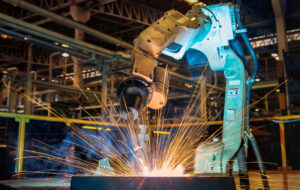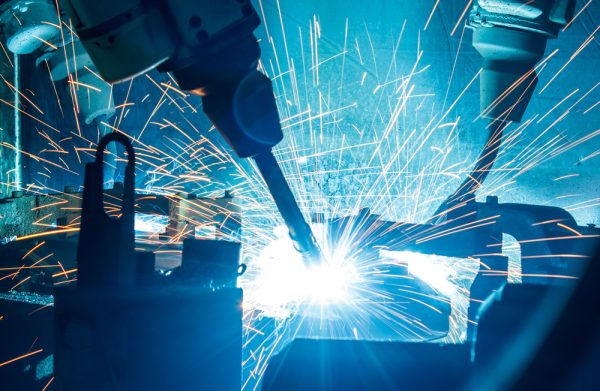How Robotic Welding Integrates Industry 4.0 in the Manufacturing Sector
The manufacturing industry in the United States is undergoing a digital transformation that is reshaping how products are manufactured, assembled, and delivered. At the core of this industry shift lies Industry 4.0 – a convergence of innovative technologies that integrate automation, data exchange, and real-time communication within metal manufacturing environments. One of the most revolutionary components of this transition is Robotic welding. Robotic welding has become a crucial factor for every forward-thinking metal manufacturing company dedicated to efficiency, scalability, and precision.

Robotic welding has evolved far beyond conventional applications. Currently, it integrates seamlessly with IoT devices, cloud computing platforms, and intelligent systems, transforming traditional factories into smart production hubs. In this blog, we will discuss how robotic welding is powering the Industry 4.0 movement in the U.S. custom metal fabrication sector.
What is Industry 4.0?
Industry 4.0 refers to the fourth industrial revolution – a paradigm that emphasizes automation, data analytics, interconnectivity, and machine learning. This era signifies the rise of smart factories, where machines communicate with one another, predict maintenance needs, reduce human error, and optimize production schedules.
For welding companies across the country, embracing the concept of Industry 4.0 is not just about innovation – it is about a requirement to stay competitive within a global market. Robotic welding performs as the key enabler of this transformation.
Role of robotic welding in industry 4.0
-
Automation meet intelligence
Conventional welding is labor-intensive, limited by human abilities, and prone to inconsistencies. Robotic welding systems, combined with intelligent software, reduce these barriers. These machines are not only automated but also capable of learning from the information they receive. With the integration of machine learning algorithms, robotic welding is capable of –
- Adjust their ways depended on joint geometry
- Correct welding errors in real-time
- Predict failures and optimize torch angles
This ability enhances quality control and eliminates downtime – a critical benefit for any metal manufacturing company operating in highly demanding industries, such as construction, automotive, and aerospace.
-
Real-time monitoring and analytics
Robotic welding systems are equipped with IoT sensors that gather massive amounts of information, from welding speed to arc length and material deposition rates. These metrics are analyzed in real-time, providing benefits that include –
- Instant adjustments to avoid weld errors
- Performance benchmarking across production lines
- Predictive maintenance alerts
-
Integration with ERP and MES systems
One of the beneficial features of Industry 4.0 is the integration of systems. Robotic welding units can be combined directly with Enterprise Resource Planning (ERP) and Manufacturing Execution Systems (MES). This infusion assures that each step in the welding procedure is traceable and coordinated with –
- Inventory management
- Job scheduling
- Quality assurance process
-
Human-Robot Collaboration (Cobots)
In various U.S. welding processes, collaborative robots (cobots) are being used to assist human welders with hazardous or repetitive tasks. These cobots are designed with safety sensors and adaptive controls to work alongside skilled laborers, reducing fatigue and increasing overall throughput.
Cobots are perfect for custom fabrication providers to manage small-batch production or complex projects that demand flexibility and human oversight, which are still valuable.
Impact on the U.S. Metal Manufacturing Industry
The combination of robotic welding within Industry 4.0 has had a remarkable impact on the United States metal manufacturing industry –
- Mitigation of labor shortage – The number of skilled welders is low in supply. Robotic welding can fill the gap and enhance productivity at the same time.
- Cost efficiency – although the initial investment is substantial, long-term savings from reduced waste, labor costs, and rework are significant.
- Consistency and precision – Automation ensures repeatable quality, which is crucial for industries that demand high precision, such as automotive and defense.
- Scalability – Whether it is a small-scale custom fabrication or mass-volume production, the robotic welding technique scales seamlessly to meet demand.
Future Outlook
The future of robotic welding within the context of Industry 4.0 is exclusively promising. As AI, cloud computing, and sensor technology continue to evolve, robotic welding procedures will become even more predictive, autonomous, and intelligent. It will further streamline production cycles, increase quality, and enhance global competitiveness for American manufacturers.

With increasing interest in metal fabrication with customized features, robotic welding will remain the cornerstone of innovation and creativity in the United States industrial landscape.
Final thoughts
Industry 4.0 is not merely a buzzword – it is a roadmap for a faster, brighter, and more resilient future of manufacturing. Robotic welding will be the central element of this revolution, providing fabrication companies with the capability to produce with greater efficiency and lower risk across the United States.
Still searching for reliable welding companies near me? Connect with Cresco to embrace robotic welding – a strategic move to thrive in the era of smart manufacturing.
FAQ:
Q1. How does robotic welding benefit custom metal fabrication?
Robotic welding is ideal for custom metal fabrication tasks that require accuracy and speed, as it offers consistency, reduces human error, and expedites turnaround times.
Q2. Can small welding companies adopt robotic welding systems?
Indeed, small enterprises may now affordably integrate automation thanks to the development of cobots and modular welding systems.
Q3. What skills are needed to operate robotic welding equipment?
Operators should be trained in the use of robotic interfaces and sensors, possess a basic understanding of programming, and have a comprehensive knowledge of welding procedures and techniques.
Q4. Where can I find welding companies near me that use robotic welding?
Robotic welding technologies are being adopted by numerous contemporary welding businesses throughout the United States. You can locate qualified suppliers by conducting a local internet search using keywords such as “robotic welding services” or “welding companies near me.”


